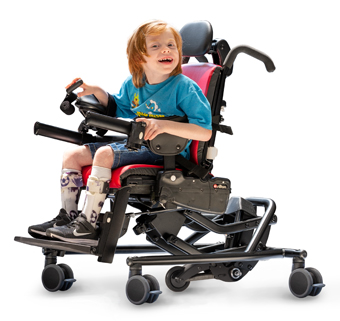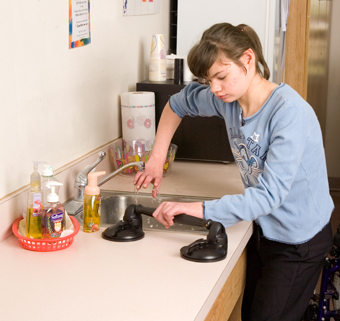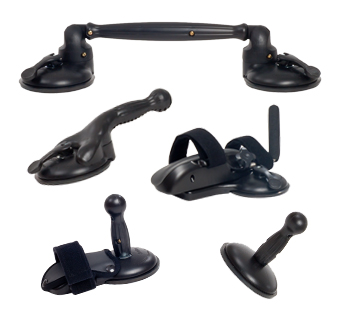Feeding Chairs for Children with Special Needs
Optimal Positioning, Successful Feeding
| April 2013 Therapists, teachers and parents are well aware that children with cerebral palsy and other disabilities can face more challenges (and pose more challenges) than the average child. This can be particularly true during mealtimes.
Therapists, teachers and parents are well aware that children with cerebral palsy and other disabilities can face more challenges (and pose more challenges) than the average child. This can be particularly true during mealtimes.
Feeding problems commonly associated with disability include dysphagia (difficulty swallowing), and gastro-intestinal reflux (spitting up frequently) as well as oral defensiveness (strong reaction against certain food textures, temperatures, or tastes, and gagging). Other well-recognized issues include tongue thrusting, prolonged or exaggerated bite reflex, an abnormally increased or decreased gag reflex, and drooling. Whether difficulties with eating are minor or significant, any parent or care provider knows about coping with prolonged mealtimes. These can stretch up to 15 minutes longer than for other children, due to slower eating or excessive spillage. Worse, the incoordination of the swallowing mechanism may result in a stressful or even potentially life-threatening choking episode. Aspiration (inhaling fluid or solid) can occur during swallowing or with gastric reflux, and this in turn can contribute toward coughing, chronic wheezing, bronchitis, or general ill health.  All in all, it is not unusual for children with special needs to receive inadequate nourishment, and even to be evaluated with “failure to thrive” due to decreased weight and height when compared to typically developing peers of the same age.
All in all, it is not unusual for children with special needs to receive inadequate nourishment, and even to be evaluated with “failure to thrive” due to decreased weight and height when compared to typically developing peers of the same age.
Besides the oromotor concerns mentioned above, children with special needs such as cerebral palsy often present with decreased postural control. The child’s abnormal muscle tone and dysfunctional movement patterns can further exacerbate feeding problems or even compromise the feeding/swallowing process. One aspect of feeding that is true for all children is that they are (most commonly) sitting while eating. Postural control is widely recognized as a significant component of feeding success. With appropriate positioning in a feeding chair, the child with special needs can achieve the alignment and stability to facilitate the trunk and head control necessary for swallowing. A stable pelvis contributes toward trunk alignment, which improves head control and thus jaw stability. Optimal positioning with therapeutic seating is undeniably a crucial component to successful feeding. Besides improving postural and oromotor control, proper positioning improves visual control and can enhance the ability to self-feed. A thorough feeding evaluation includes an assessment of positioning problems and recommendations regarding the child’s feeding chair. This assessment is usually completed by the physical therapist or occupational therapist and includes observation and recommendations regarding head control, trunk control, foot stability, placement of the hip and pelvis, shoulder girdle, knee flexion, and the child’s sitting base. 
Many professionals work together with families and teachers to increase the safe intake of food. These include the speech language pathologist, occupational therapist, physical therapist, dietician, as well as gastroenterologist, nurse, and/or psychologist. To help the family and school staff overcome the challenges that arise with mealtimes, a team approach is critical.
Therapists have a key role to advocate for the child and family and form the link between parents, other healthcare providers or medical experts and very importantly, the day-to-day care providers and school staff.
A new brochure from Rifton on using the Activity Chair for feeding purposes aims to be a communication tool between therapists and the other persons and disciplines represented on the team. This brochure is appropriate for parents, medical staff, school personnel, and equipment providers. (You can request a free copy - or copies - from Rifton by phoning 800-571-8198 or emailing sales@rifton.com.)
The Rifton Feeding Chair Brochure highlights the importance of tilt-in-space and seat and back angle adjustment to optimize positioning for various aspects of the feeding process. It also notes that head positioning while in the feeding chair has important consequences for the process of swallowing, and plays a key role.
It is important for therapists to respect the role of parents and care providers, to share information, and be supportive, reassuring and understanding. Assisting the parent and teachers toward implementing successful feeding strategies and therapeutic positioning will make a huge difference.
Most importantly, the child should feel as comfortable as possible in the feeding chair during mealtimes. Eating is social, and can be a positive daily experience where motor skills are learned and achieved. The right feeding chair with the right adjustments can make all the difference.
See Also: A Letter of Medical Necessity For a Rifton Feeding Chair. This letter, written by an OT, was instrumental in gaining funding for a Rifton Activity Chair for feeding purposes.




